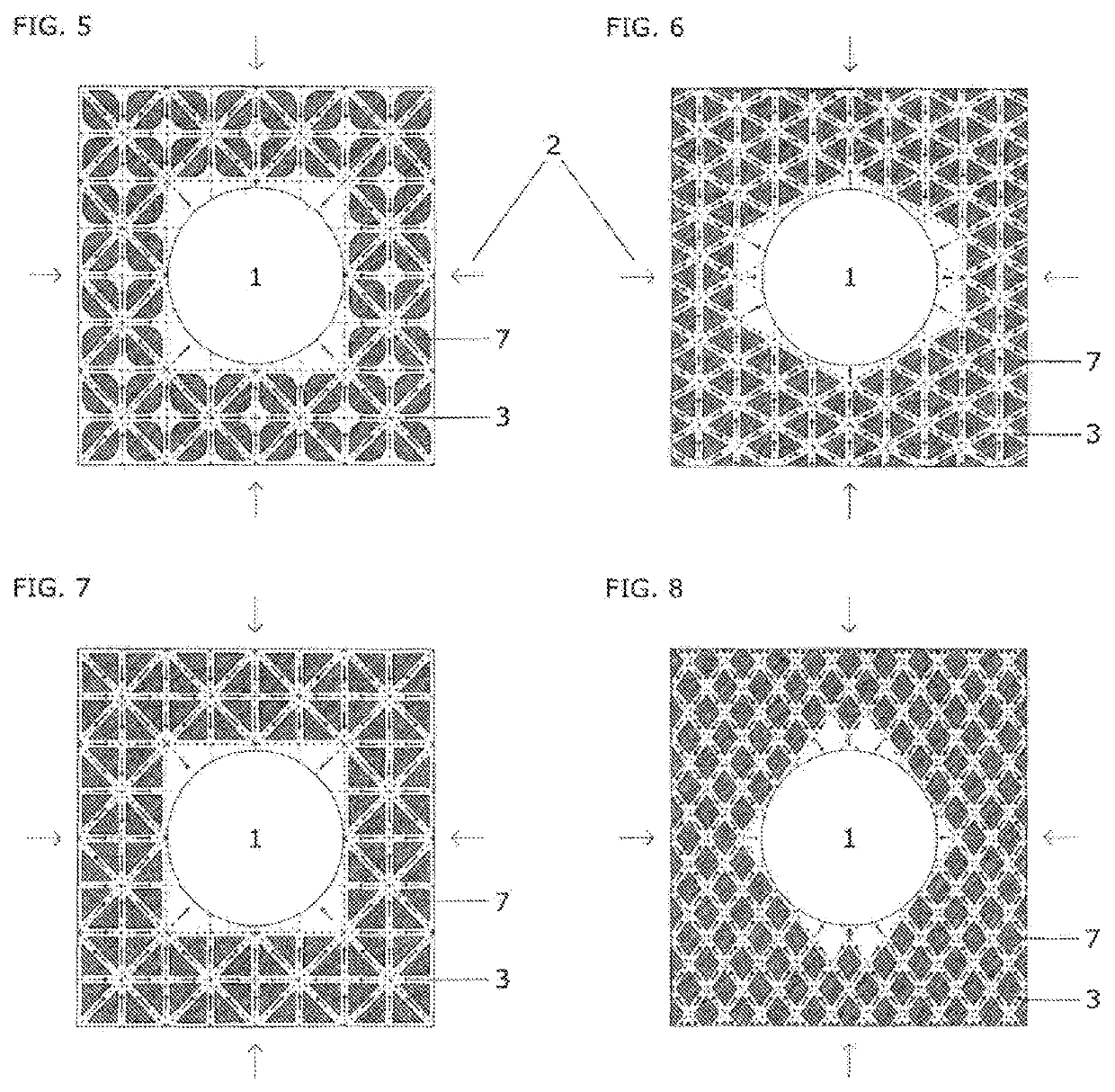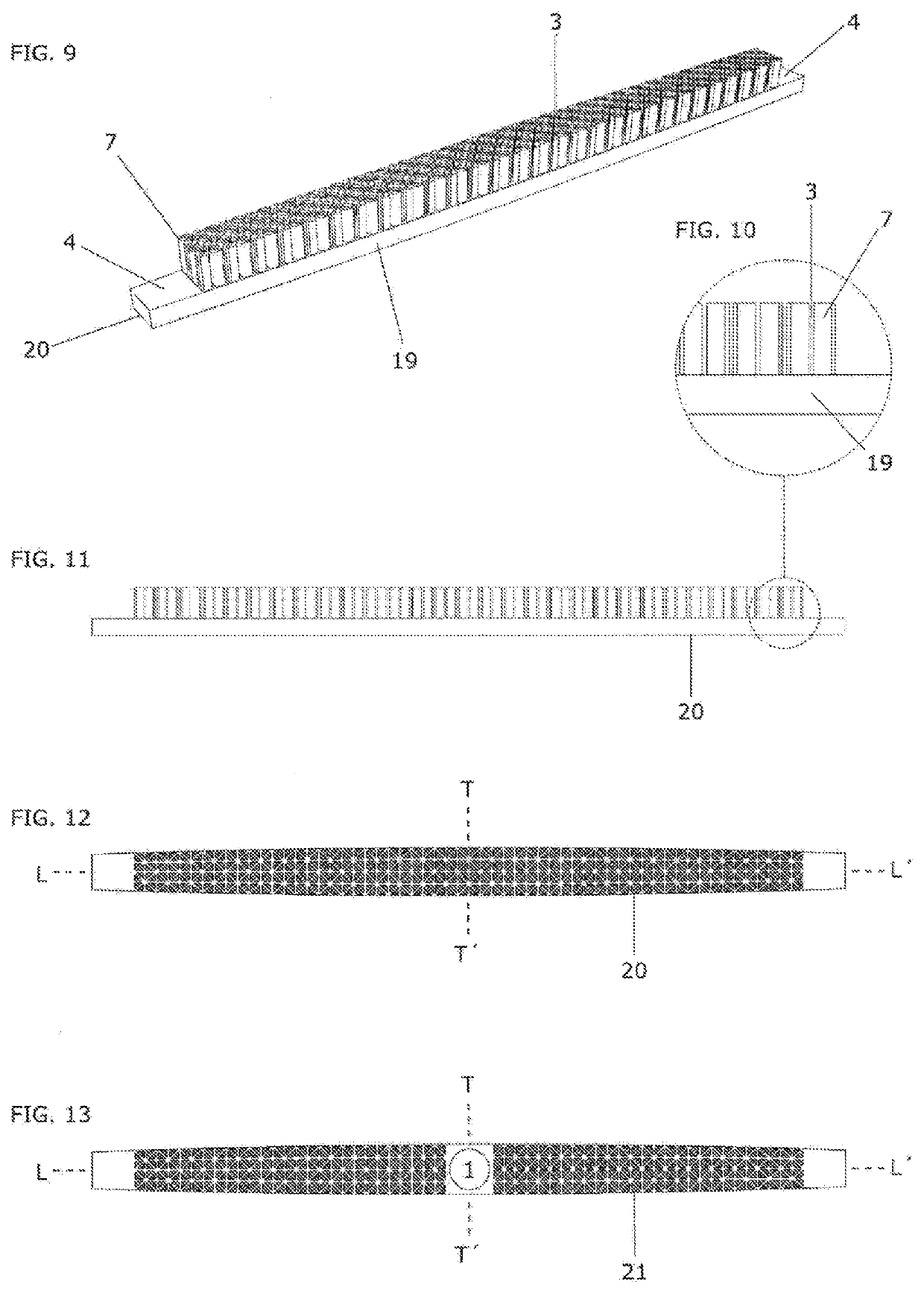Wooden stave and barrel for drinks
a technology for wooden barrels and drinks, applied in the field of wooden barrels for drinks, can solve the problems of unsatisfactory improvement, loss of the total volume of the resulting liquid, and unwanted storage of liquid inside the barrels
- Summary
- Abstract
- Description
- Claims
- Application Information
AI Technical Summary
Benefits of technology
Problems solved by technology
Method used
Image
Examples
second embodiment
[0068]A second embodiment presented in FIG. 2 shows a detail of a stave formed by a pattern of geometric elements 7 resulting from a framework defined by a certain number of axes, arranged in three directions, a first direction D2-1, a second direction D2-2 and a third direction D2-3 and in a parallel and equidistant manner between the ones corresponding to each direction D2-1, D2-2 and D2-3. One of the three directions, the first direction D2-1 of the framework, preferably coincides with one of the two main axes of the barrel, the transverse axis (T-T′) or the longitudinal axis (L-L′). The axes arranged in an equidistant manner in each of the three directions, the first direction D2-1, the second direction D2-2 and the third direction D2-3, meet each other at common intersection points, forming a triangular mesh, the sides thereof being equal in size and shape, in this case, equilateral triangles. Since the internal angle of an equilateral triangle is 60°, six triangles come togeth...
third embodiment
[0070]A third embodiment presented in FIG. 3 shows a detail of a stave used for the examples of FIGS. 18 to 19 and FIGS. 20 to 25, being the same as the embodiment of FIG. 1 with the difference of the bases of the geometric elements 7 being triangular prisms with bases in the shape of right-angled triangles, where the right angle thereof does not receive a subsequent curvature treatment. Said pattern in the application thereof to the stave is preferably adapted and arranged parametrically to the perimeter or contour of the internal side of the stave, such that the axes arranged in a parallel and equidistant manner in each of the four directions D3-1, D3-2, D3-3 and D3-4 can have variations in direction between those corresponding to each of the first, second, third and fourth directions D3-1, D3-2, D3-3 and D3-4, said axes therefore losing the parallel condition thereof, for which reason the resulting triangular mesh will be formed by triangles with different sizes and shapes. The m...
fourth embodiment
[0071]A fourth embodiment, presented in FIG. 4, shows a detail of a stave formed by a pattern of geometric elements 7 resulting from a framework defined by a certain number of axes, arranged in two directions, a first direction D4-1 and a second direction D4-2 and in a parallel and equidistant manner between the axes corresponding to each direction D4-1 and D4-2, creating a mesh of irregular polygons, in this case of rhombuses. These two directions, first D4-1 and second D4-2, could also be arranged orthogonally to each other and with a rotation preferably of 45° with respect to the main axes of the barrel, the transverse axis (T-T′) or longitudinal axis (L-L′), such that the internal diagonals of the polygons of the framework, which join the opposite vertices together, were parallel to the two main axes of the barrel, the transversal axis (T-T′) or longitudinal axis (L-L′). The machining is performed along the axes of the framework, creating the first and second channels 3 in the a...
PUM
 Login to View More
Login to View More Abstract
Description
Claims
Application Information
 Login to View More
Login to View More - R&D
- Intellectual Property
- Life Sciences
- Materials
- Tech Scout
- Unparalleled Data Quality
- Higher Quality Content
- 60% Fewer Hallucinations
Browse by: Latest US Patents, China's latest patents, Technical Efficacy Thesaurus, Application Domain, Technology Topic, Popular Technical Reports.
© 2025 PatSnap. All rights reserved.Legal|Privacy policy|Modern Slavery Act Transparency Statement|Sitemap|About US| Contact US: help@patsnap.com



